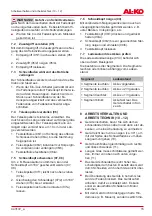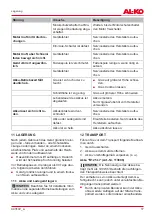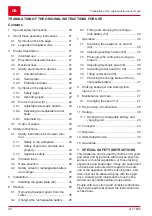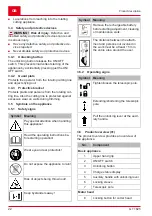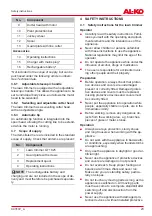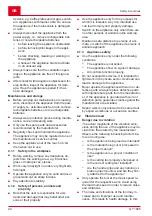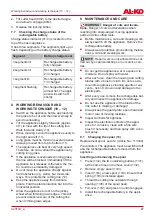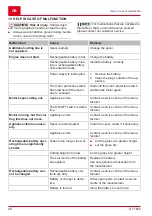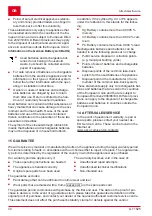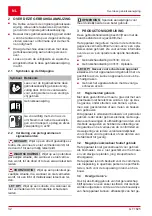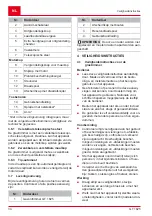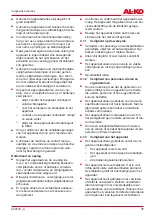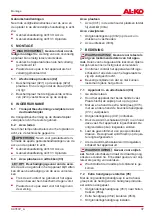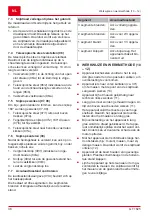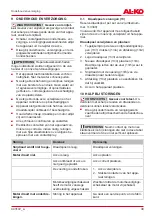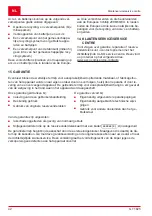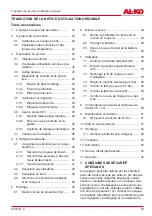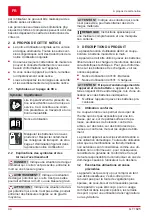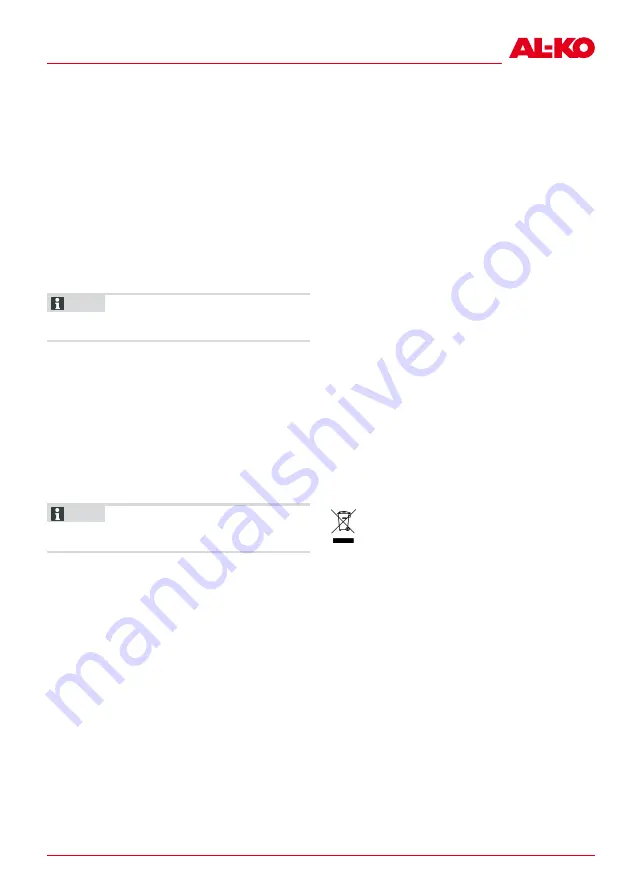
443172_a
29
Storage
11 STORAGE
Thoroughly clean the appliance after each use
and – if present – attach all covers. Store the ap-
pliance in a dry, lockable place out of the reach of
children.
■
Hang up the lawn trimmer by its handle. This
avoids placing unnecessary load on the cut-
ter head.
Carry out the following jobs before intervals in
work lasting for longer than 30 days:
■
Thoroughly clean the appliance and store it in
a dry place.
11.1 Storing the rechargeable battery and
charging unit
NOTE
For detailed information, heed the
separate operating instructions for the recharge-
able battery and for the charging unit.
12 TRANSPORT
Before transporting, carry out the following mea-
sures:
1. Switch off the appliance.
2. Remove the rechargeable battery from the
appliance.
3. Pack the battery properly (see below).
Rechargeable battery “B125 Li” (Art. No.
113896)
NOTE
The nominal energy of the recharge-
able battery is more than 100 Wh. Therefore, ob-
serve the following transport instructions.
The li-ion rechargeable battery contained in the
appliance is subject to the hazardous goods law,
but can be transported under simplified condi-
tions:
■
The rechargeable battery can be transported
on public roads by the private user without
further conditions provided it is packaged for
retail sale and the transport serves personal
purposes.
■
Commercial users who carry out the trans-
port in connection with their main activity
(e.g. delivery from and to building sites, or
demonstrations) can also take advantage of
this simplification.
In both cases, it is essential to take the mandato-
ry precautions mentioned above to prevent any
leakage of the contents. In other cases, it is es-
sential to comply with the regulations of the haz-
ardous goods law. In the case of non-compli-
ance, severe penalties can be imposed on the
sender and possibly the transporter.
Additional notes on transport and shipment
■
Only transport or send the li-ion rechargeable
battery in an undamaged condition.
■
For transporting the rechargeable battery, on-
ly use the original cardboard box or a suitable
hazardous goods cardboard box (not re-
quired for rechargeable batteries with a nomi-
nal energy less than 100 Wh).
■
Tape off exposed rechargeable battery con-
tacts to avoid a short circuit.
■
Secure the rechargeable battery against
shifting in the packaging to avoid damage to
the rechargeable battery.
■
Ensure the correct marking and documenta-
tion of the shipment for transport or shipping
(e.g. by parcel service or freight forwarding).
■
Check in advance that transport with the se-
lected service provider is possible and indi-
cate the shipment.
We recommend involving a hazardous goods
specialist in preparation of the shipment. Also
heed any further national regulations.
13 DISPOSAL
Information on the German Electrical and
Electronic Equipment Act (ElectroG)
■
Electrical and electronic appliances do
not belong in household waste, but
should be collected and disposed of
separately.
■
Used batteries or rechargeable batteries that
are not installed permanently in the old appli-
ance must be removed before disposal. Their
disposal is regulated by the battery law.
■
Owners or users of electrical and electronic
appliances are obliged by law to return them
after use.
■
The end user bears personal responsibility
for deleting his personal data from the old ap-
pliance to be disposed of.
The symbol of the crossed-through rubbish bin
means that electrical and electronic appliances
may not be disposed of in the household rubbish.
Electrical and electronic appliances can be hand-
ed in at the following places at no charge:
■
Public service disposal or collection points
(e.g. municipal building yards)
Summary of Contents for 113963
Page 3: ...443172_a 3 01 1 2 3 4 5 6 7 14 8 9 10 11 12 13 15 16 16 02 1 2 4 3 03 1 2 a b not included ...
Page 4: ...4 GT 1825 04 1 2 05 1 a 2 b 06 a b 2 1 07 08 09 1 2 a b 10 11 a 1 b 2 ...
Page 5: ...443172_a 5 12 13 1 1 2 a a 3 4 b 5 6 ...
Page 250: ...250 GT 1825 ...
Page 251: ...443172_a 251 ...

